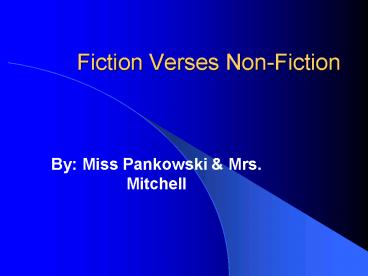Fiction Verses Non-Fiction - PowerPoint PPT Presentation
1 / 32
Title:
Fiction Verses Non-Fiction
Description:
Fiction Verses Non-Fiction By: Miss Pankowski & Mrs. Mitchell Objectives Identify the criteria necessary in a nonfiction piece. Identify the elements of fiction as ... – PowerPoint PPT presentation
Number of Views:606
Avg rating:3.0/5.0
Title: Fiction Verses Non-Fiction
1
Fiction Verses Non-Fiction
- By Miss Pankowski Mrs. Mitchell
2
Objectives
- Identify the criteria necessary in a nonfiction
piece. - Identify the elements of fiction as applied to a
short story. - Differentiate a fiction and nonfiction book.
3
Elements of Fiction
4
Fiction
- Fiction A story from an authors imagination.
- Two Forms
- 1.Short Story
- Can easily be read in one sitting
- Explores one topic
- 2.Novel
- Has a longer more complicated plot
5
4 Components of Fiction
- Plot
- The events of the story
- Characters
- The people, animals, or imaginary characters in
the story
- Setting
- The time and place where the story occurs.
- Theme
- The main message in the story.
6
Elements of Non-Fiction
7
WHAT IS NONFICTION?
- The subject of nonfiction is real
- The author writes about actual persons, places
and events. - The writer may just report facts
- The writer may also include personal opinions
- Often there is a mixture of both
- Readers must read critically
8
CRITICAL READING
- Look at writers background
- Look at writers purpose
- Look at writers attitude
- Look at writers audience
9
PERSONAL CHRONICLES
10
DIARIES AND JOURNALS
- Diaries a private form of writing with no
further intended audience - Journals varying styles and topics. Give a
glimpse of the writers value of his or her world
11
LETTERS
- Private Letters
- Public Letter
- Letters can
- Reveal character
- Express opinions
- Ask for information
- Give information
- Audience and Purpose influence tone.
12
PERSONAL REFLECTIONS
- Personal Reflections must be memorable and
significant and - Give character insight
- Lead to an unexpected conclusion
- Show how a lesson was learned
- Awaken feeling of pity, compassion, joy and
nostalgia
13
Biography
- Written about a persons life or one main event
- Has a plot
- Can be read in one sitting or have many chapters
- Historical biographies include strands of an
individuals life interwoven with historical
persons, places and events.
14
Autobiography
- The biography of a person written by himself or
herself. - Has a plot
- Can be read in one sitting or have many chapters
- Author has some purpose for writing
- To teach
- To gain awareness
- To warn
- Simply to entertain
15
MEMOIRS
- A type of autobiographical writing, dealing with
the recollections of prominent people or people
who have been a part of or have witnessed
significant events. - Considered both autobiographical and historical.
16
Encyclopedia
- Information organized by topic
- Topics organized alphabetically
- The entries are short
- Used for research
17
JOURNALISM
- Newspapers
- Magazines
- Online sources
18
TYPES OF JOURNALISM
- Interviews
- Columns
- Reviews
- Articles
- Editorials
- Editorial Cartoons
19
News Paper Articles
- Short
- Can be read in one sitting
- Articles Focuses on one topic or main idea
20
Essay
- Can be based on research or personal experience
- Can be read in one sitting
- Written in paragraph form, usually five or more
21
TYPES OF ESSAYS
- Formal Essay
- A prose discussion on a serious topic in a
serious manner, usually rigidly structured and
organized.
- Informal Essay
- A prose discussion on any topic in a light,
humorous, amusing manner often loosely
organized, rambling and casual in approach.
22
CHARACTERISTICS of an Essay
- The Formal Essay
- Purpose to inform, explain, convince
- Tone serious, rhetorical, balanced
- The Informal Essay
- Narrative structure
- Tone conversational, sometimes witty and
humorous
23
HUMOR AND THE ESSAY
- Wit
- Incongruity
- The unexpected
- Exaggeration
- Humor
- Ability to show, with sympathy, the things in
life and human behavior that are funny.
24
OTHER TYPES OF ESSAYS
- Comparison and Contrast Essays
- Persuasive Essays
- Cause and Effect Essays
25
Interview
- Recorded word for word
- Can be read in one sitting
- May be written in bullet format or like a drama
26
Textbook
- Information organized by topic
- Used for reference to inform
- Organized chronologically (by time) or by topic
27
OTHER TYPES OF NONFICTION
- Speeches
- Historical Writing
- Science Writing
- Technical writing
- Writing online
- Miscellaneous writing
28
ELEMENTS OF NONFICTION
- Characters, Plot, and Setting. Like fiction but
all are real - Person in autobiography or biography called a
subject - Purpose changes the style and tone of the piece
- Tone (authors attitude toward the topic) -based
on purpose and audience.
29
HOW TO READ NONFICTION
- Try to separate facts from opinions.
- The writer has chosen facts that present a
certain picture of the subject. - Think about what might be missing as well as what
is there.
30
MORE READING TIPS
- Think about the writer's purpose.
- Is the writer trying to win you over to his or
her opinion? - Learn to appreciate how well a writer says
something, even when you don't agree. - Be a critical reader.
31
FINAL READING TIPS
- Be aware of the writer's tone.
- Pay attention to what the author reveals about
himself or herself especially true in
autobiography
32
Questions?































